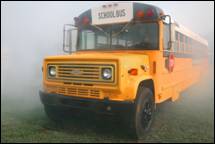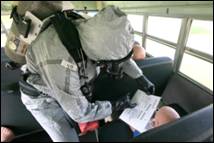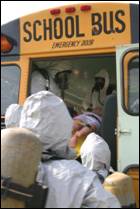
The Center for Domestic Preparedness (CDP) in Anniston, Alabama is known for its realistic, emergency response exercises. Responders attending the Hands-On Training for CBRNE Incidents (HOT-I) course will now have an added level of realism thanks to a school bus CDP recently added to the simulated mass casualty exercise for each class.
Complete with smoke and child-size mannequins crowding seats and aisles, the school bus will resemble a potential emergency scene. This training element is typical of many CDP courses, which remove first responders from the classroom for a unique hands-on training experience that focuses on response to a chemical, biological, radiological, nuclear, and explosive (CBRNE) incident.
“It was intense. When I first entered the bus visibility was good but as the smoke thickened the level of difficulty increased,” said Heather Jenkins, an Emergency Medical Technician (EMT) from California, after completing her training scenario. “My ultimate goal was to find the most critical patient, but it was not easy. This is something I have never experienced before, but it gave me an idea of what to expect—I feel more prepared. This is crucial knowledge anyone in emergency response should experience.”

“Incorporation of the school bus into training scenarios lends an element of realism that keeps our student-participants motivated,” said Mick Castillo, CDP technology integration specialist. “The scenario incorporates over 20 lifelike pediatric mannequins, an implementation that assists in simulating a mass casualty incident involving two dozen children. Whether caused by simple accident or at the hands of a terrorist, this scenario is as lifelike and realistic as we can make it.”
At a recent training session, students prepared for the exercise as they received information explaining the circumstances and potential victims or survivors. As they departed the classroom setting a series of explosions were heard from the nearby fictional city known as “Northville.” As the smoke rose, instructors commanded responders to “go on air,” prompting the class to quickly don their breathing apparatus and divide into multiple response teams.
When the first team entered the bus they noticed child-size mannequins with a variety of symptoms. The students had to quickly assess the dangerous situation, triage victims, and remove survivors from the smoky bus. The first survivor was quickly passed through the bus’ emergency exit to waiting responders—only to find out from instructors the injured child was not viable. The response team inside the bus carefully re-examined the scene and symptoms of other passengers and discovered a survivor. The survivor was quickly passed through the emergency exit and emergency responders rushed the child away to a safe area to begin decontamination procedures.
“Where I work there is always a chance for a mass casualty event, and incorporating a training aid like the school bus creates a more realistic environment that requires students to perform,” said Chris Dew, a fire fighter/paramedic from the District of Columbia. “There is a reason I have returned here five times. The training is invaluable. Experiencing triage like this and decontamination during a CBRNE response has increased my confidence 100 percent.”

For more information regarding the HOT-I course, view the CDP training courses at http://cdp.dhs.gov. The HOT-I course is an eight-hour course commonly combined with other CDP training allowing students to build on previous day’s exercises in a CBRNE setting. As part of the course, the responder enters the CDP’s toxic agent training facility and performs hazardous materials technician operations in a CBRNE response environment using nerve agents GB and VX.
CDP training focuses on incident management, mass casualty response, and emergency response to a catastrophic natural disaster or terrorist act. CDP training for state, local, and tribal responders is fully funded by FEMA, a component of the U.S. Department of Homeland Security. Round-trip air and ground transportation, lodging, and meals are provided at no cost to responders or their agency.

